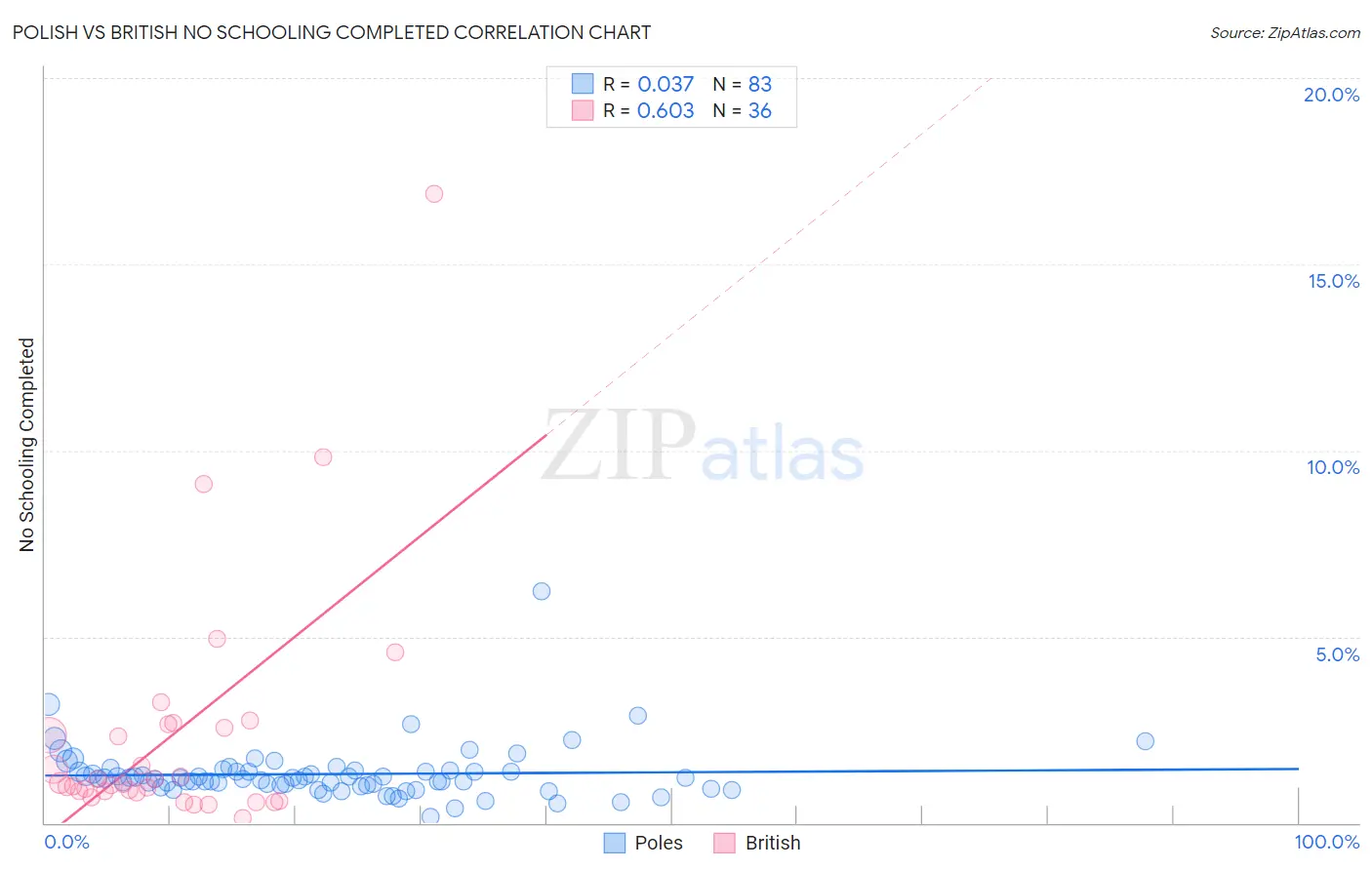Polish vs British No Schooling Completed
COMPARE
Polish
British
No Schooling Completed
No Schooling Completed Comparison
Poles
British
1.4%
NO SCHOOLING COMPLETED
100.0/ 100
METRIC RATING
13th/ 347
METRIC RANK
1.5%
NO SCHOOLING COMPLETED
100.0/ 100
METRIC RATING
30th/ 347
METRIC RANK
Polish vs British No Schooling Completed Correlation Chart
The statistical analysis conducted on geographies consisting of 543,036,846 people shows no correlation between the proportion of Poles and percentage of population with no schooling in the United States with a correlation coefficient (R) of 0.037 and weighted average of 1.4%. Similarly, the statistical analysis conducted on geographies consisting of 518,649,413 people shows a significant positive correlation between the proportion of British and percentage of population with no schooling in the United States with a correlation coefficient (R) of 0.603 and weighted average of 1.5%, a difference of 5.8%.

No Schooling Completed Correlation Summary
| Measurement | Polish | British |
| Minimum | 0.16% | 0.14% |
| Maximum | 6.2% | 16.9% |
| Range | 6.1% | 16.8% |
| Mean | 1.3% | 2.4% |
| Median | 1.2% | 1.1% |
| Interquartile 25% (IQ1) | 1.00% | 0.83% |
| Interquartile 75% (IQ3) | 1.4% | 2.6% |
| Interquartile Range (IQR) | 0.39% | 1.8% |
| Standard Deviation (Sample) | 0.74% | 3.3% |
| Standard Deviation (Population) | 0.74% | 3.3% |
Demographics Similar to Poles and British by No Schooling Completed
In terms of no schooling completed, the demographic groups most similar to Poles are Irish (1.4%, a difference of 0.030%), Lithuanian (1.4%, a difference of 0.050%), Scotch-Irish (1.5%, a difference of 0.94%), Tlingit-Haida (1.5%, a difference of 1.0%), and Finnish (1.5%, a difference of 1.5%). Similarly, the demographic groups most similar to British are Inupiat (1.5%, a difference of 0.030%), Lumbee (1.5%, a difference of 0.48%), French Canadian (1.5%, a difference of 1.4%), Scandinavian (1.5%, a difference of 1.4%), and Czech (1.5%, a difference of 1.9%).
| Demographics | Rating | Rank | No Schooling Completed |
| Lithuanians | 100.0 /100 | #11 | Exceptional 1.4% |
| Irish | 100.0 /100 | #12 | Exceptional 1.4% |
| Poles | 100.0 /100 | #13 | Exceptional 1.4% |
| Scotch-Irish | 100.0 /100 | #14 | Exceptional 1.5% |
| Tlingit-Haida | 100.0 /100 | #15 | Exceptional 1.5% |
| Finns | 100.0 /100 | #16 | Exceptional 1.5% |
| Croatians | 100.0 /100 | #17 | Exceptional 1.5% |
| Danes | 100.0 /100 | #18 | Exceptional 1.5% |
| Alaskan Athabascans | 100.0 /100 | #19 | Exceptional 1.5% |
| Welsh | 100.0 /100 | #20 | Exceptional 1.5% |
| Chinese | 100.0 /100 | #21 | Exceptional 1.5% |
| Alaska Natives | 100.0 /100 | #22 | Exceptional 1.5% |
| Europeans | 100.0 /100 | #23 | Exceptional 1.5% |
| Pennsylvania Germans | 100.0 /100 | #24 | Exceptional 1.5% |
| French | 100.0 /100 | #25 | Exceptional 1.5% |
| Czechs | 100.0 /100 | #26 | Exceptional 1.5% |
| Scandinavians | 100.0 /100 | #27 | Exceptional 1.5% |
| French Canadians | 100.0 /100 | #28 | Exceptional 1.5% |
| Lumbee | 100.0 /100 | #29 | Exceptional 1.5% |
| British | 100.0 /100 | #30 | Exceptional 1.5% |
| Inupiat | 100.0 /100 | #31 | Exceptional 1.5% |